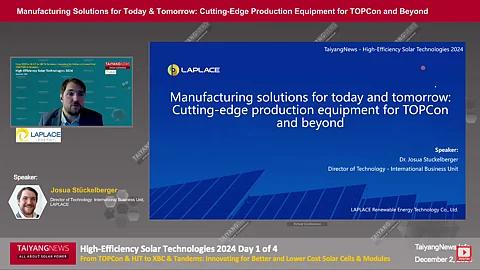

LAPLACE, a comprehensive TOPCon cell production tool supplier, can upgrade its tools, to be reused in the XBC cell line
The company's 5th generation LPCVD platform can ensure the integrity of the deposited tunneling oxide (SiOx) layer in the XBC cell line, irrespective of etch-back or laser ablation-based process flow
The tool maker has come up with multiple laser tools, featuring advanced BC-laser technology, for the XBC cell line
The 3 main n-type PV cell technologies that have been commercialized are TOPCon, HJT, and XBC. TOPCon holds the largest market share, largely due to its optimized CapEx and OpEx for mass-scale cell production. According to InfoLink Consulting’s August 2024 high-efficiency cell capacity forecast (GW), TOPCon’s total capacity is expected to reach 2,065 GW by 2028, followed by HJT at 469 GW and XBC at 164 GW. A key factor behind TOPCon's rapid global expansion in recent years has been the ability to leverage existing production tools from the p-PERC cell line for quick adaptation to the TOPCon process flow. Meanwhile, the potential for increased efficiency and power output by shifting both front and rear-side metallization contacts to the rear side of the cell structure or a back-contact cell structure (XBC) has generated significant interest among leading tier-1 cell manufacturers.
At the recent TaiyangNews annual flagship event, High-Efficiency Solar Technologies 2024, Josua Stuckelberger, director of the international business unit of LAPLACE, provided a brief overview of the company’s existing process tools for the TOPCon cell line, which can also be adapted for XBC cell lines (see LAPLACE presentation here). Established in 2016, LAPLACE is a pioneer in the mass production of TOPCon cells, having shipped over 470 GW of production tools for TOPCon, IBC, and PERC cell technologies. Of these, more than 20 GW have been delivered outside of China, specifically to Southeast Asia and the USA.
Laplace, which offers comprehensive process tools for front-side emitter formation, rear-side passivation, and metallization, categorizes its TOPCon tool portfolio by key functionalities: heat treatment, deposition, automation, and metallization.
Its 5th-generation boron diffusion tool, which uses a heat treatment process to diffuse BCl3 as a precursor and form an emitter junction under high temperature and low-pressure conditions, has been delivered over 900 times. As a pioneer in transitioning from BBr3 to BCl3 as the precursor, the boron diffusion tool offers more than 70% operational cost reduction. The company also noted the delivery of its 5th-generation phosphorus diffusion tool, which is required for doping the rear-side intrinsic polysilicon layer, to multiple clients. Additionally, LAPLACE provides other heat treatment tools, including oxidation and annealing process tools.
A strong proponent of the LPCVD deposition method for applying a thin p-Si film on top of the tunneling oxide layer for rear-side passivation, LAPLACE has made significant advancements. Notable technological improvements include back-to-back wafer loading (double loading), in-house heating elements, and quartz tubes with internal coatings. The double-loading mechanism has doubled the throughput of LPCVD, while in-house heating elements enhance thermal uniformity and extend quartz tube lifespan. The introduction of nano-crystallization technology for pre-coating inside the quartz tubes has further extended tube life by up to 9 months. LAPLACE also offers Atomic Layer Deposition (ALD) tools for front-side Al2O3 layer deposition in TOPCon cell structures.
After covering its TOPCon production tools, LAPLACE shifted its focus to process tools for XBC cell technology, compatible with both TBC and Hybrid Back-Contact (Hybrid BC) cell structures. Presenting a typical process flow for XBC cell fabrication – which includes texturing, LPCVD poly-Si, phosphorus diffusion, masking, laser grooving, etching and cleaning, additional LPCVD poly-Si, boron diffusion, etching and cleaning, oxidation, anti-reflective coating on both sides, laser P-N isolation, and metallization – the company compared each step with the TOPCon process steps. It emphasized that all tools used in the TOPCon process can be reused for XBC after equipment upgrades.
The company identified 3 new process steps for XBC: masking, laser grooving, and laser P-N isolation. According to LAPLACE, the integrity of the tunneling oxide (SiOx) layer, in terms of stability, reproducibility, and uniformity, must be maintained throughout all subsequent process steps. The company believes its 5th-generation LPCVD tool can meet these critical requirements. Additionally, LAPLACE has expanded its portfolio with new BC laser tools, including laser-induced oxidation, XBC cell laser contact opening, thickness reduction via laser ablation, and laser-induced metallization.
The company also shared its latest TBC tool shipment capacity, achieving an average mass-production efficiency of 27% that translated into 24.2% module efficiency, with 18 GW installed and a projected capacity of 35 GW for TBC cell structures by 2025. For Hybrid BC cell structures, with an average mass-production efficiency exceeding 26.6%, resulting in a 25.4% module efficiency, the current installed capacity is 34.5 GW, and the total capacity is expected to reach 70 GW by 2025.
